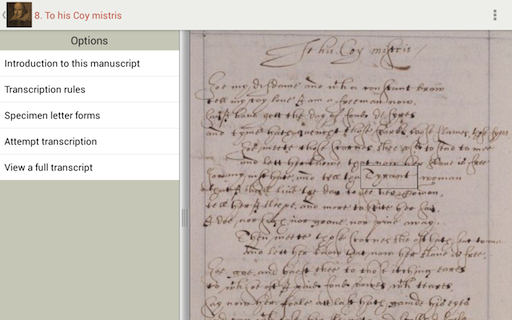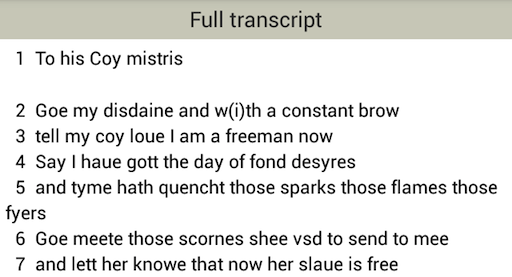English Renaissance Handwriting
The origins of this app lie in online exercises in palaeography developed for postgraduate students at the University of Leeds in West Yorkshire, U.K. The aim is to provide practice in the transcription of sixteenth and seventeenth century hands. Many of the manuscripts, especially after 1600, use a varying mixture of secretary and italic letter forms.
 |
To select a manuscript, tap on its thumbnail image. |
 |
After selecting the manuscript, you will see an image of it on the right hand side of the screen and a list of options on the left. You can drag the divider to change the proportions of each side shown. You can also use your finger to move the image or use a pinch gesture to zoom it in or out. |
 |
If you tap on a word, it will zoom out to an isolated view. If the word was partially obscured by others, the obscuring marks will have been removed so that you can read the word more clearly. Tap again on the word or elsewhere in the image to shrink the word back into place. |
 |
Each manuscript has an introduction giving information on its background and a commentary on the features of the handwriting. |
 |
Before attempting to transcribe the manuscript, be sure to read the rules for transcription. If you don't follow the rules, the app will disallow your transcription. Note that the rules in this app differ from those in the English Renaissance Handwriting app. |
 |
You may also find it useful to examine the letter forms found in the manuscripts in this app. Tap any of the letters in the table to see its letter forms. |


|
You can attempt to transcribe the manuscript by tapping on the appropriate option. Enter your transcription in the text box. You can start at any line in the manuscript, but you must enter at least three words. Tap Check and the app will let you know if you are correct or if there are any errors. Tap Edit to go back to your transcript. |
 |
You can check your transcript against the full transcript used by the app. (If you want to do the transcription exercise 'blind', i.e. without the full transcript being available, you can disable this option via the Settings menu item.) |
 |
You can save your transcript on your device. (If you don't yet have a transcript, this option is not visible.) |
 |
You can open previously saved transcripts. (If you don't have any saved transcripts, this option is not visible.) The saved transcript files on your device are accessible via a file manager, so you can easily transfer them to your computer or delete unwanted transcripts. |
The images, full transcripts and the introductions to each manuscript are copyright © University of Leeds. |